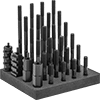Filter by
Thread Size
Material
Overall Length
Thread Direction
Thread Pitch
Thread Type
Fastener Strength Grade/Class
Thread Spacing
DFARS Specialty Metals
Tensile Strength
Component
Thread Fit
Power Transmission
Fastening and Joining
Fabricating and Machining
Fluid Handling
Facility and Grounds Maintenance













































